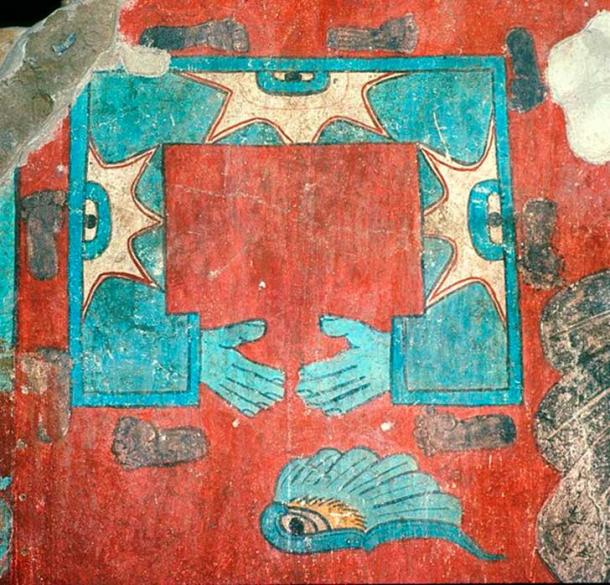
Cacaxtla: Where the Rain Dies on Earth and Murals Tell Tales of Forgotten Lives
Warriors in jaguar skins stand over their defeated opponents dressed as quetzal birds, priests invoke the sacred avian and feline powers, and a merchant sets off on a journey with a pack full of wares – these are some of the scenes which became vibrant murals of the Cacaxtla archaeological site.
Cacaxtla is located in the east-central Mexican state of Tlaxcala, not far from the country’s capital, Mexico City. Thanks to its location on the important trade routes that connected the Valley of Mexico to the Gulf in the east and to the territory of the Maya in the south, the city prospered. The ruins of Cacaxtla are today best known for their impressive mural paintings, which were discovered during the 1970s. These paintings depict a variety of subjects, including battles, deities and priests, as well as scenes of everyday life.

Mural in the Cacaxtla ruins. (Erickin Kirin/CC BY SA 3.0)
The Rise and Fall of Cacaxtla
The name Cacaxtla is said to translate literally as ‘Where the Rain Dies on Earth’, though it may also mean ‘Place of the Basket / Merchant’s Pack’. This city is reckoned to have prospered from around the 7th to the middle of the 10th centuries AD.
- The Controversial Role of La Malinche in the Fall of the Aztec Empire: Traitor or Hero?
- Peering Through Time: Early Mirrors in Mesoamerica - Elite Item and Divination Tool
- Archaeological site in Mexico reveals sacrifice and cannibalization of Spanish conquistadors
Prior to the rise of this city, the area was dominated by the city state of Teotihuacan, which was the largest city in the Americas during its height of power. When Teotihuacan went into decline, and collapsed around the 7th century AD, it was an opportunity for smaller states in the region to fill the void. One of these was Cacaxtla, which prospered from its advantageous location along the area’s important trade routes. The city is thought to have been occupied up till around the 950s.
Archaeological Excavations
Unfortunately, no writings about the site are known to have survived, and knowledge about Cacaxtla has been gained is only through the archaeological remains. The first systematic archaeological investigation of the site is reported to have been undertaken by a German archaeologist in 1969. Several years later, in 1975, the first two mural paintings were discovered at the site. More murals were discovered subsequently, and these became the highlights of the site.
The focal point of Cacaxtla was the Gran Basamento, or Great Platform, a natural platform on which the city’s main religious and civil buildings were built. This was also the area of the site that archaeologists have concentrated their efforts on. Today it is sheltered by a sheet-metal roof. It was here that the mural paintings were unearthed.

The Gran Basamento, or Great Platform, at the Cacaxtla archaeological site. (Hajor/CC BY SA 3.0)
Marvelous Murals
The best-known of these murals is the so-called ‘Battle Mural’, located in the northern part of the Gran Basamento. This mural depicts warriors in jaguar skins, the victors, standing over their defeated opponents, who are unarmed and wearing dresses of the quetzal bird.
Some have interpreted this scene as a ritual battle, whilst others have proposed that these portrayed the warriors of Cacaxtla overcoming enemies in an actual battle. Other murals include a figure of a merchant with his merchant pack, an example of everyday life, and the ‘Bird Man’ and ‘Feline Man’, who may be representations of the priestly rulers of the city.
- The Golden Age of Texcoco, Powerful City of King Nezahualcoyotl
- Treasures of Mexico: The Mixtec, Aztec & Maya Codices that Survived the Conquistadors
- Archaeologists discover astronomical observatory linked to sun worship in Mexico

Section of the ‘Battle Mural.’ (Cristophe Morisset/CC BY NC SA 2.0)
The murals of Cacaxtla have been well-preserved and have received the attention of archaeologists and art historians. One of the main questions surrounding these paintings concerns the identity of the artists who painted them. Certain aspects of these murals, such as the colors used, as well as the features of the figures, resemble those produced by Maya people, who lived about 650 km (403.9 miles) to the south of Cacaxtla. These Mayan elements have led some to argue that the murals were made by Mayan artists, either itinerant ones, or those who had previously been living in Teotihuacan.
Others, however, are of the opinion that whilst Mayan influence is present in the murals, they were created by local artists. It has been pointed out, for instance, that the glyphs on the paintings are not Mayan. Additionally, the murals were created over many years, and it would be quite unlikely for Mayan artists to return to Cacaxtla over several generations to make new paintings. Therefore, it has been hypothesized that the artists were local, and that they passed their skills down to the next generation, making it possible for the murals to be created over a long period of time.

Cacaxtla, Tlaxcala, Mexico: building A, glyph. (HJPD/CC BY 3.0)
Top image: The ‘Bird Man’, one of the mural paintings in Cacaxtla. Source: El Comandante/CC BY SA 3.0
By Wu Mingren
References
abrock.com, 2018. Cacaxtla. Available at: http://abrock.com/MexicoWeb/Cacaxtla/Cacaxtla.html
Allen, S., 2015. Mexican murals reveal art’s power. Available at: https://www.uchicago.edu/features/mexican_murals_reveal_arts_power/
Angelo, C., 1988. Who Painted Cacaxtla Ruins, and Why? : Mexico Murals Pose a Mystery. Available at: http://articles.latimes.com/1988-01-17/news/mn-36487_1_mexico-city
delange.org, 2018. Cacaxtla Archaeological Ruins. Available at: https://delange.org/Cacaxtla/Cacaxtla.htm
Lonely Planet, 2018. Cacaxtla & Xochitécatl. Available at: https://www.lonelyplanet.com/mexico/east-of-mexico-city/cacaxtla-and-xochitecatl















